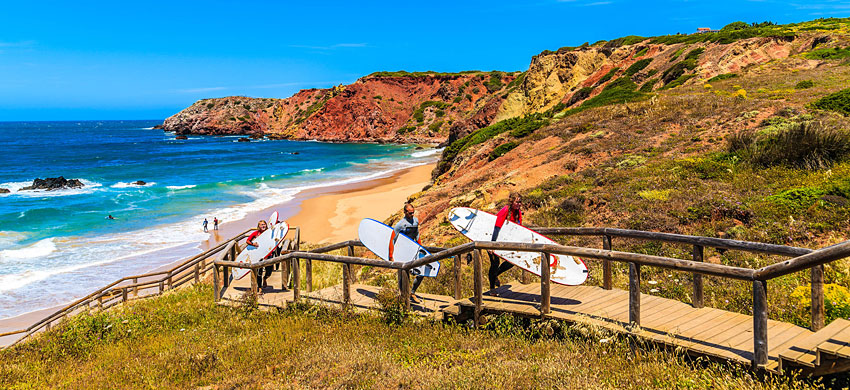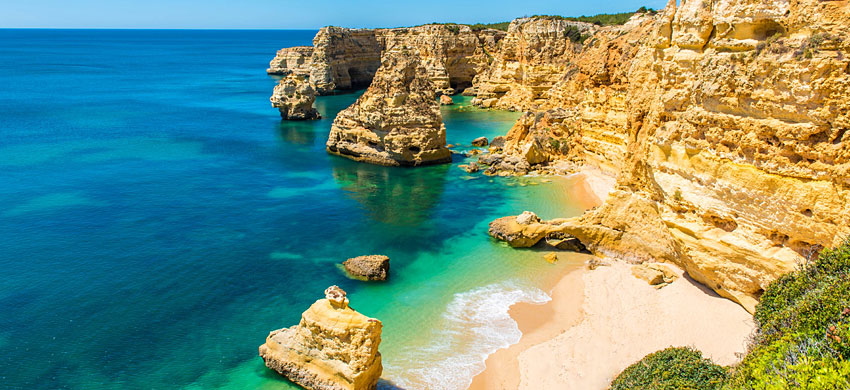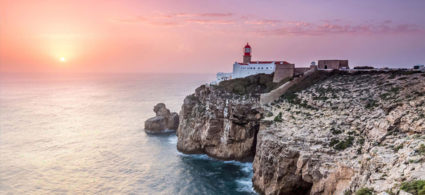

The Algarve region, located in the south of Portugal, is a unique location thanks to its 150 kilometres of coastline overlooking the Atlantic Ocean. The region is the perfect mix between nature and culture, and it is one of the most developed tourist destinations in Europe.
Often hastily labelled as the region of mass tourism in Portugal, Algarve still offers the curious traveller numerous opportunities for a holiday of culture and nature.
Beautiful beaches with fine sand and crystal-clear water, high cliffs against which thunderous waves break, romantic sunsets over the sea, pretty city centres, walks in parks and nature reserves are just some of the wonders that await you if you decide to continue your holiday in Lisbon with a detour to the south.
Due to its mild climate, the Algarve can be visited all year round. During the summer you can bask in the sun and cool off with a dip in the sea. In winter, the south of Portugal is less busy. It takes on a nostalgic and proud charm and is perfect for those looking for a quiet holiday.
We could answer to this question with just one single word: “light”. In the Algarve region the sun never stops shining and the weather is almost perfect.
But there is much more about it: this is a region of hidden gems, golden beaches, cliffs and rocks, as well as small and simple restaurants where to taste some very fresh and delicious fish.
Many of its natural areas are UNESCO World Heritage Sites. More over, just like the rest of Portugal, this region is quite affordable, meeting the budget of all kind of travelers.

Each area of the Algarve region has its own characteristics. Inland, among the mountain range of Monchique you will feel like time has stopped, and the life of its residents follows the passing of the seasons.
In the villages, characterized by narrow streets, the houses are white and there are so many cafes crowded by men who are sip their drink while women are grill sardines on the street.
The life on the coast is different, though. This area is very touristic, even if not all the villages are fully crowded. Along the coast you will find some fishing villages and some tourist villages offering all the best services and comforts.
On the east side of the region there are a number of small yet beautiful guest houses where you can enjoy your vacation without having to be surrounded by so many tourists. The center and the west area of the region are way more touristic.
There are some stretches of coast characterised by cliffs overhanging the sea which are perfect for those who wish to spend their holiday in contact with nature. Other destinations that are very popular among surfers: here waves are pure fun. Thanks to their spacious beaches, some other villages are a great option for those who wish to spend a typical beach holiday.
Albufeira and Vilamoura are the two most developed towns: these are also the perfect bases to explore the region.
Wherever you decide to spend your holiday, you will find very warming and friendly people, some great local wines – at great prices – and some very yummy food all over Algarve.

One of the main region that invites so many tourists to visit the southernmost region of Portugal are its stunning beaches. Along the coast of the Algarve region there are a number of long beaches, bays, coves, where to enjoy a sunbath, surf, or take stunning photos. These are some of the most beautiful beaches in the Algarve:
Feeling like finding more about the best beaches in the Algarve region?

The main cities in the Algarve are Faro, Albufeira and Lagos, in addiction to many interesting inland villages and along the coast.
Albufeira is the Algarve’s main beach resort and the village that has suffered most from the consequences of mass tourism. Completely transformed by the overbuilding triggered by the tourism boom, the town now resembles an unbroken line of apartment blocks and villas for tourists to rent. However, it is still pleasant to take a walk along the waterfront in the town centre: the waterfront is 2 kilometres away from the old town, so as not to contaminate its quieter, family-friendly air, although there are still plenty of bars and restaurants for tourists.
Faro is the capital of the Algarve and the nerve centre of the region. It is worth visiting for the Cidade Veilha (old town), the marina and some interesting churches. It’s often overlooked by tourists, even though it has an historic centre with walls dating back to the 11th century. Choose Faro to spend at least the first two days of your holiday and then move along the coast.
Meeting point of all the surfers who arrive to the south of Portugal, Lagos is one of the youngest and most lively places in the Algarve region. The city is worth a visit thanks to its several clubs, but also squares, churches, streets, white houses decorated with azulejos and a city wall dating back to the XIV century.
Tavira is located about 3 km from the coast, along the shores of the river Gilão. It is a charming village with roman origins and a very well preserved center, where you will have the chance to admire a castle from the XVII century, a Roman bridge, and the ancient water tower of the city.
The tiny village of Sagres is worth a visit thanks to its stunning viewpoint, which is one of the most famous all over the Algarve region. From here you can easily reach the cliff of Cabo de São Vicente, the very last bit of southern Portugal facing the Atlantic Ocean.
Algarve is famous for its nightlife, which is hard to beat. Every night there is something that meets the needs of everyone.
Whether you are looking for a quiet family bar or for a place where to party and celebrate a bachelor’s party, you will find the perfect place for you.
The wide range of bars and clubs scattered all over the Algarve meet the needs of every traveler. There are elegant lounge bars and DJ set on the beach, clubs, and music bars. Different types of entertainment that enhance the natural beauty of this region.
The several tourist towns along the coast offer plenty of choice; you can spend a perfect night enjoying an elegant happy hour, maybe tasting some white vinho verde – like the famous Soalheiro – and have the opportunity to taste some excellent red and rose Portuguese wines.
The weather conditions in the Algarve region are pretty good all year long. The high season goes from May to October: during this period you will find many tourists. Visiting the Algarve region during the high season gives you the opportunity to find more flight options.
Choosing to visit the Algarve during the other months of the year can still be a good idea if you wish to find some relax and you want to stay off the classical touristic paths. The only negative point about this choice is that some tourist attractions, such as water parks or restaurants, may be closed.
Renting a car is the best way to move around the region, considering that public transports are pretty limited. It is possible to rent a car at Faro airport or at one of the main cities in the Algarve.
Most of the companies require a minimum age of 21 years old for the driver. As an alternative, you can still move by train, clearly limiting the number and the speed of your travels.
Many companies from all over Europe fly to Faro. Once you arrive to the airport, you can take one of the several buses connecting to the train and the bus stations. There are daily connections between Faro, Lagos, and Olhao.
The national company TAP Portugal operates direct flights between Lisbon and Faro: they only last 45 minutes, but are very expensive so we do not recommend them. There are some direct buses and trains to Faro, as well as some less frequent trains to Lagos (you may have to change at some point). The length of the ride varies, but it usually takes about three and a half hours. Faro is connected to the main towns and villages of the Algarve region by bus and local trains, which – however – are not very frequent.
The best way to reach the Algarve region from Lisbon is by renting a car, which allows you to have the freedom to leave whenever you want. It will take less than three hours to reach the Algarve by driving down the A2 motorway; however, if you are not on a rush, avoid the motorway and stop by the serveral villages along the way.
Having a car will be very useful once in the Algarve because it will allow you to reach even the most isolated beaches that not can’t be reached by public transports.



















